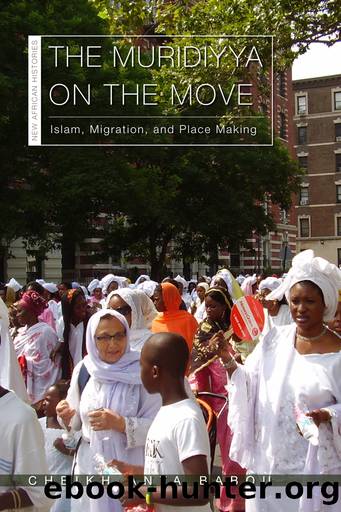The Muridiyya on the Move: Islam, Migration, and Place Making by Cheikh Anta Babou

Author:Cheikh Anta Babou
Language: eng
Format: epub
Publisher: Ohio University Press
Published: 2021-04-15T00:00:00+00:00
MAP 6.1. Places of importance to Murids in New York City. Map drawn by Eric Ross.
In 1990, four years after moving to Harlem, Fadel Gey opened Sunugaal Halal Meats and Poultry on 119 West 116th Street.60 Sunugaal was one of the first businesses owned by a postcolonial sub-Saharan African in Harlem.61 Fadel had no personal experience in commerce. However, as he recalled, âWith the number of Muslims coming for prayer every Friday at the mosque (Malcolm Shabazz) I thought that selling fresh halal meat would be profitable.â62 Fadelâs business not only benefited from the mosque worshippers but also from Arab shopkeepers in the area and the Senegalese restaurants that opened on and around 116th Street. Yuusu Caam, a Murid disciple, launched the restaurant Soumbedioune in 1990; a year later, Sëriñ Lo collaborated with a fellow Murid to start Xeewal, then Keur Sokhna, Africa Kiné, Le Baobab, and more recently, Les Ambassades would follow. All of these eateries were patronized by a Muslim customer base (they do not sell alcohol or pork), but they also drew an African American and White American clientele, especially among the middle class, including former Peace Corps volunteers and students and professors from nearby Columbia University.
The dynamic restaurant business combined with a vibrant social lifeâwhere cooking and sharing food is centralâstimulated demand for African produce. This demand was met by entrepreneurial Murids and other Africans who opened grocery stores along West 116th Street from Frederick Douglass to Malcolm X boulevards. The businesses sold dried fish, palm oil, the broken rice favored in the Senegalese staple dish ceebu jen, couscous, bouillons, peppers, a variety of powdered milks, Nescafé, chocolate, and other items imported from Senegal or bought from Asian wholesalers in New York. Stores also offered suitcases catering to the needs of mobile Senegalese immigrants; there were also Islamic goods, fabrics, cellphones, and other electronics. In addition to the stores and restaurants, there were hair salons managed by African and Caribbean women alongside tailors and barbershops. By the late 1990s, it was estimated that 80 percent of businesses on West 116th Street were owned by Senegalese.63 In the words of anthropologist Paul Stoller, the Senegalese became âthe aristocracy of West African merchants in New York City.â64
As in Senegal, some storefronts were converted into grands-places, especially when the weather warmed up. In Senegal, especially in rural areas where most Murid immigrants originated from, people spend much of their time outdoors. Rooms are only for sleeping. In Harlem, the grand-place plays the role of an urban palaver tree; this is a gendered space where men (and only men) meet when they are retired or not working to chat, gossip, relax, share tea or café Tuubaa, and play the French games of checkerboard or belote (card game) with much noisy laughter and arguing. One of those grands-places located in front of a tailorâs shop was dubbed Nations-Unies (United Nations) to connote the ethnic and national diversity of the people who frequented the place.65 The âAfrican Unionâ would have been a more fitting name because most of those who patronized the place were from West African countries.
Download
This site does not store any files on its server. We only index and link to content provided by other sites. Please contact the content providers to delete copyright contents if any and email us, we'll remove relevant links or contents immediately.
The History of Jihad: From Muhammad to ISIS by Spencer Robert(2575)
Nine Parts of Desire by Geraldine Brooks(2328)
The Turkish Psychedelic Explosion by Daniel Spicer(2314)
The First Muslim The Story of Muhammad by Lesley Hazleton(2222)
The Essential Rumi by Coleman Barks(1992)
1453 by Roger Crowley(1974)
The Last Mughal by William Dalrymple(1834)
Trickster Travels: A Sixteenth-Century Muslim Between Worlds by Davis Natalie Zemon(1815)
God by Aslan Reza(1616)
Muhammad: His Life Based on the Earliest Sources by Martin Lings(1609)
by Christianity & Islam(1596)
A Concise History of Sunnis and Shi'is by John McHugo(1547)
Magic and Divination in Early Islam by Emilie Savage-Smith;(1501)
No God But God by Reza Aslan(1500)
The Flight of the Intellectuals by Berman Paul(1467)
Art of Betrayal by Gordon Corera(1403)
Nothing to Envy by Barbara Demick(1389)
What the Qur'an Meant by Garry Wills(1363)
Getting Jesus Right: How Muslims Get Jesus and Islam Wrong by James A Beverley & Craig A Evans(1312)
